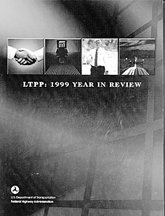U.S. Department of Transportation
Federal Highway Administration
1200 New Jersey Avenue, SE
Washington, DC 20590
202-366-4000
Focus
| Accelerating Infrastructure Innovations |
Publication Number: FHWA-RD-00-057
Date: April 2000
After 10 years of gathering pavement performance data, the long-term pavement performance (LTPP) program has amassed 11 gigabytes of data-and counting. Who's using the data and how are they using it? And how can the data be obtained?
The data collected from the 2,400 LTPP test sections across the country have been put to work in a range of Federal Highway Administration (FHWA) projects, including analyzing the variability in the data to devise guidelines for achieving a desired level of certainty when collecting distress data. The data are also playing a significant role in the development of the American Association of State Highway and Transportation Officials 2002 Guide for the Design of New and Rehabilitated Pavement Structures. And the LTPP program is increasingly dispersing the data to users both across the country and internationally.
The primary source for LTPP data is the DataPave 2.0 software, which covers such elements as climate, load, materials, response, structure, and distress. According to Monte Symons at FHWA, the software now has over 2,400 registered users. These include federal government staff and contractors; State, provincial, and local transportation agencies; universities; and private industry. Ten international users are also registered.
Sixty-five percent of the respondents to a recent LTPP customer service questionnaire indicated that they are using the LTPP data or products. Those who have obtained copies of DataPave are using the program for everything from pavement roughness analysis to studying the effects of overload on concrete pavements to developing a temperature prediction model. The data have also been put to work in State and local pavement research efforts, including studies of traffic, roughness, and seasonal changes, and in choosing Superpave binders. One customer noted that it is "great to have that volume of information available," while another noted the "definite improvement" in the new 2.0 version of DataPave. Other customers have sent in suggestions for even further improvement, including adding more data to the program and making the software tables more user friendly.
Free copies of the DataPave software can be obtained from LTPP Customer Support Services at 423-481-2967 (email: ltppinfo@fhwa.dot.gov). More information is also available at the DataPave Web site (www.tfhrc.gov/pavement/ltpp/datap/page1.htm).
For more information on how the LTPP data are being used, check out the LTPP program's new annual report: LTPP: 1999 Year in Review. The report can be found on the Web at www.fhwa.dot.gov/publications/research/infrastructure/pavements/ltpp/99year.cfm.
